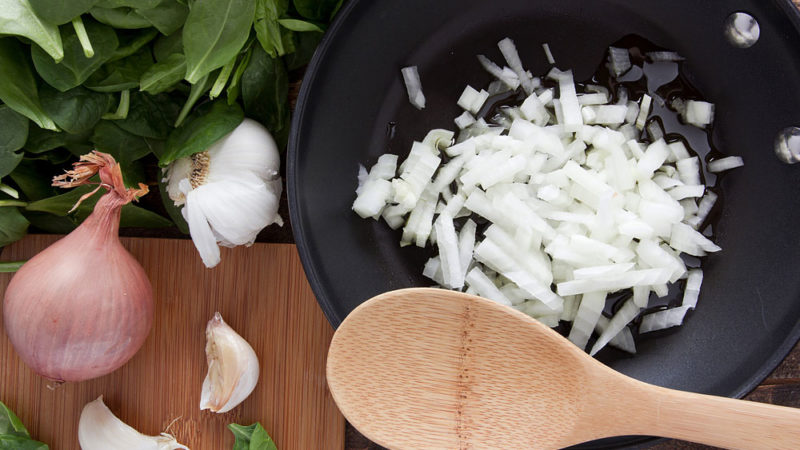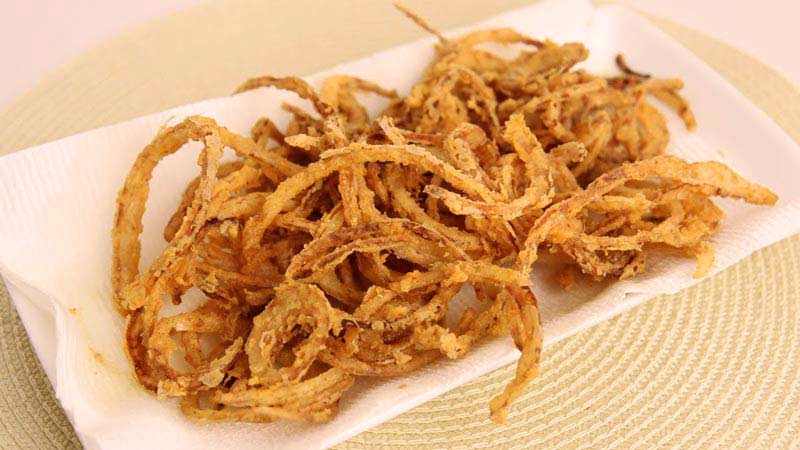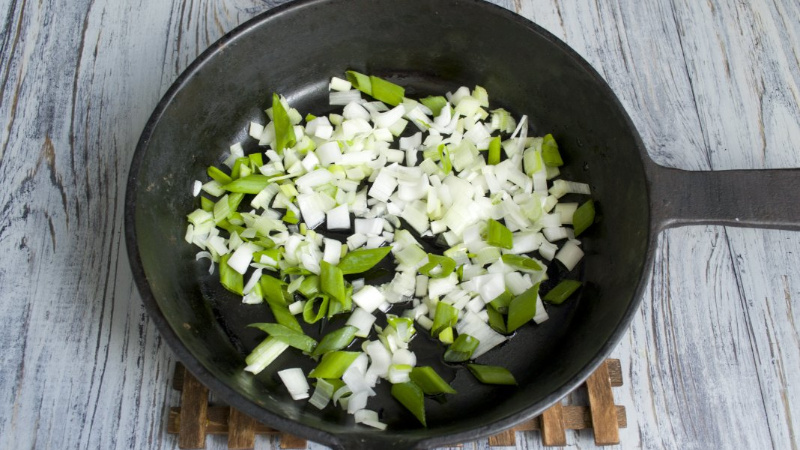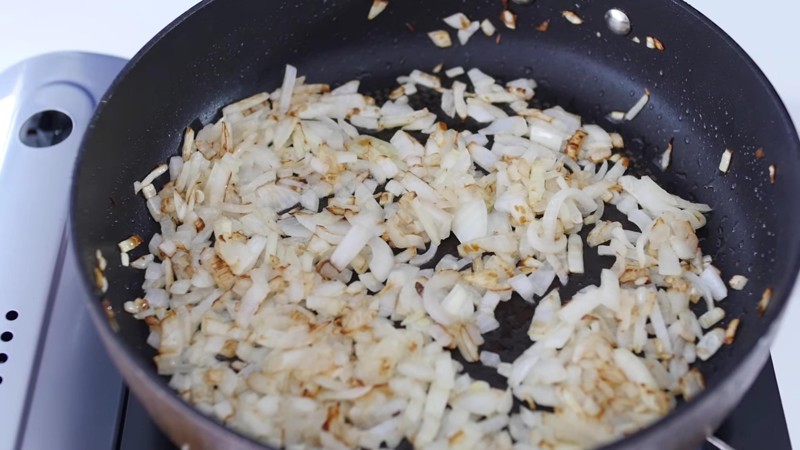Is it possible to eat fried onions while losing weight and what is its calorie content
Onions are a vegetable that practically no dish is complete without. It is added to salads, soups, sauces, side dishes, pastries, meat dishes. Many use it is fresh, but it is no less useful during heat treatment.
From the article you will find out how many calories are in fried onions, what beneficial properties it has, and whether there are any contraindications to its use.
The content of the article
Chemical composition and nutritional value
100 g of the product contains:
- vitamins:
- PP - 0.9 mg;
- E - 0.7 mg;
- K - 21.6 μg;
- C - 1.8 mg;
- B1 - 0.05 mg;
- B2 - 0.02 mg;
- B4 - 6.5 mg;
- B5 - 0.2 mg;
- B6 - 0.2 mg;
- B9 - 2 mcg;
- B7 0.9 mcg.
- trace elements:
- phosphorus - 33 mg;
- sodium - 12 mg;
- potassium - 133 mg;
- calcium - 20 mg;
- manganese - 0.1 mg;
- iron - 0.3 mg;
- magnesium - 9 mg;
- zinc - 0.2 mg;
- iodine - 3 mcg.
- essential oils;
- amino acids.
Calorie content, BJU and glycemic index

Nutritional value per 100 g:
- 4.5 g of proteins;
- 13.5 g fat;
- 27.5 g of carbohydrates;
- 5.8 g dietary fiber;
- 45 g of water;
- 3.9 g starch;
- 2.7 g of ash.
Usually, the calorie content of onions depends on the chosen cooking method: fried in sunflower oil - 251 kcal per 100 g, and in olive oil - 256 kcal.
The glycemic index of raw onions is 15, but when frying, this figure rises to 98.
Attention! To preserve nutrients, fry the vegetable in refined olive oil with the lid open.
Useful properties for the body
Onions have the following properties:
- strengthens the immune system, and the high content of vitamins increases the tone of the body and improves health;
- thanks to folic acid, it is useful for pregnant women - it participates in the formation of the fetus and improves mood;
- recommended for people with diabetes, stimulates the production of insulin;
- has soothing properties, improves sleep quality;
- fights fungal diseases;
- used in cosmetology - affects the condition of hair, skin and nails;
- improves metabolism, improves food digestion;
- has a diuretic effect;
- relieves puffiness;
- normalizes water-salt balance;
- removes toxins and toxins from the body;
- increases the level of iron in the blood.
Fried onions are included in the diet of those who suffer:
- atherosclerosis;
- kidney disease;
- oncology;
- colds and viral diseases.
Harm and contraindications for use
Despite a number of positive properties, there are contraindications:
- Gastritis and an ulcer, especially during an exacerbation, problems with the pancreas.
- Liver disease... Due to the high fat content after frying, such food increases the stress on the organ.
- Allergy and individual intolerance.
- Childhood - fried onions are hard to digest.
- Heart and vascular problems. In large doses, it provokes sudden surges in pressure, headaches, tachycardia.
- Asthma. This rarely happens, but still a choking attack is possible due to a specific smell.
Heat-treated vegetables can cause heartburn and bloating, and bad breath.
Consumption rate

Adults who have no contraindications are advised to consume fried onions 2-3 times a week. Serving size will vary based on the individual and personal taste. On average, no more than 100 g.
Important! Excessive consumption of fried onions can lead to health problems.
How to reduce the calorie content of fried onions
It would seem that there is nothing easier than frying onions. But for the greatest benefit, follow the recommendations for preparing this product.
How and what to fry
All types of onions are suitable for heat treatment, but the more bitter ones are best. The vegetable is used as an independent dish, in the form of frying for soups and borscht, as a side dish.
Attention! The calorie content of onions fried in vegetable oil ranges from 215 to 250 kcal.
Here are some tips on how to reduce the calorie content of onions when frying:
- Rinse, peel, cut and pat dry using paper towels or napkins. This removes excess moisture and allows the onion to absorb less oil during cooking.
- Fried in various oils: sunflower, coconut, olive, linseed, butter. The lower the energy value of the oil, the lower the calorie content of the onion.
- Frying oil is diluted with water in a 1: 1 ratio. Leave the lid on the pan when frying, as this will evaporate the liquid faster.
- After frying, blot the finished product with a paper towel to absorb excess oil.
How to fry onions: simple but delicious recipes

Preparation:
- Chop or divide 200 g of onion into rings.
- Fold in a deep container and add 4 tbsp. l. flour. Use oatmeal, cornmeal, or whole grains to make a meal dietary. Mix gently.
- Add oil to a preheated skillet and put onions. Don't forget to stir. Cook until golden brown over low heat. Salt at the end of frying, otherwise the onion will become too soft.
You can also cook a vegetable in the oven:
- Preheat the oven to 180 ° C.
- Slice the onion into rings, roll in flour, egg and breadcrumbs.
- Grease a baking sheet with oil, place the rings and bake for 20 minutes.
This option will replace chips.
Can I eat it while losing weight

Use water instead of cooking oil to reduce the calories in fried onions. Chop the vegetable finely, put the pan on low heat, send the onion there, stir constantly. To give it a richer flavor, add a little vinegar. If you want to stew onions, add more water to the pan.
People who want lose weight, it is worth limiting the use of fried onions. In moderation, it has a beneficial effect on metabolism, but if you overdo it, it provokes excess weight gain.
Conclusion
Onions are an invaluable source of vitamins and minerals, not only raw, but also fried. If you want to maintain health, fill the body with nutrients and vitamins, then include fried onions in your diet.
Remember that it is worth observing the measure of use and adhering to the recommendations for preparation, otherwise you risk harming your health.